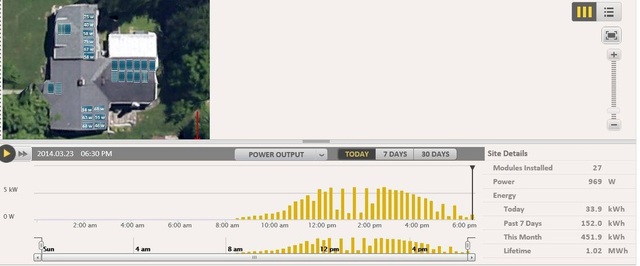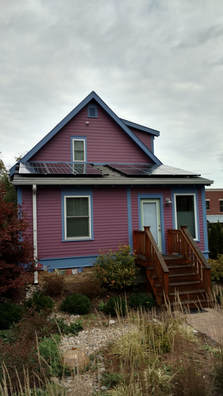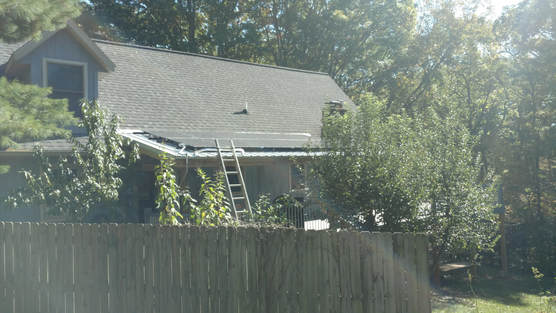Now Is the Time for Solar
 This is a kilowatt hour reading taken during a sunny March day from a solar system installed in December.
This is a kilowatt hour reading taken during a sunny March day from a solar system installed in December.
The time is running out!
Once your utility's total solar and wind energy output reaches 1.5%, no more net metering will be allowed, even if you install during the last grandfather window.*
Don't delay and miss your last chance to have net metering!
Solar panel electricity systems are simple and brilliant.
Here’s how they work.
The sun’s energy is collected in photovoltaic cells that are grouped into an array of panels mounted on roofs or free-standing structures. The photovoltaic cells create electricity from sunlight’s photons.
To use the sun’s energy, the system sends the DC (direct current) electricity generated by the solar panels to a solar power inverter.
The inverter converts it into the AC (alternating current) electricity needed to heat, cool, and light homes as well as run appliances and charge batteries.
The AC goes to the home’s electrical panel, where it is used just like the electricity delivered by a utility company. The system includes a small computer that tracks the performance of each panel.
Grid-tied is the most common type of solar electric system installed. In a grid-tied system, some or all of the electricity you use comes from the sun. It pulls power from the solar panels, sends excess power to the power company’s grid, or uses power from the grid when more is needed. If power generated by the solar panels is sent to the grid, that excess can turn your meter backwards (called net metering), or in certain rural REMC situations, can be sold to the utility.
Other systems include a battery backup, and can be off-grid.
Is there enough sun in Indiana? Yes.
An array of solar panels produces the most electricity on sunny days, but it still generates power on overcast days. Germany, known for its rainy, cloudy weather, has long been a world leader in solar power. Indiana has almost twice the sun hours as Germany.
The first step in exploring solar is to ask us to do a solar site assessment of your property to evaluate the position of the sun, shading, electrical use, and other factors.
How long do solar panels last?
Solar panels are effective and durable. They have no moving parts and need little maintenance. Systems typically last 25-40 years, with output declining slightly over time.
It’s a wise idea to install panels on a new roof so they can age together. Or consider a new deck, yard pavilion, or ground mount system.
What about return on investment?
The pay-back period depends on the amount of energy used and the size of the system. Larger systems tend to cost less per kW and costs are recouped more quickly. According to SIREN, a 4kW (kilowatt) solar system will produce 4800 kWh (kilowatt hours) each year, or about half the electricity an average Bloomington household needs.
Solar electricity is a green, renewable energy source that does not release carbon dioxide. A typical household in this area uses 11,000 kWh per year. That’s 22,000 lbs. of carbon emissions from coal burned to generate the electricity. Every solar Kw is a clean one. The costs of utility-provided energy are on the rise and are likely to continue rising, making a solar investment more profitable over time.
Learn more about solar power from others in this area from Southern Indiana Renewable Energy Network (SIREN).
Once your utility's total solar and wind energy output reaches 1.5%, no more net metering will be allowed, even if you install during the last grandfather window.*
Don't delay and miss your last chance to have net metering!
Solar panel electricity systems are simple and brilliant.
Here’s how they work.
The sun’s energy is collected in photovoltaic cells that are grouped into an array of panels mounted on roofs or free-standing structures. The photovoltaic cells create electricity from sunlight’s photons.
To use the sun’s energy, the system sends the DC (direct current) electricity generated by the solar panels to a solar power inverter.
The inverter converts it into the AC (alternating current) electricity needed to heat, cool, and light homes as well as run appliances and charge batteries.
The AC goes to the home’s electrical panel, where it is used just like the electricity delivered by a utility company. The system includes a small computer that tracks the performance of each panel.
Grid-tied is the most common type of solar electric system installed. In a grid-tied system, some or all of the electricity you use comes from the sun. It pulls power from the solar panels, sends excess power to the power company’s grid, or uses power from the grid when more is needed. If power generated by the solar panels is sent to the grid, that excess can turn your meter backwards (called net metering), or in certain rural REMC situations, can be sold to the utility.
Other systems include a battery backup, and can be off-grid.
Is there enough sun in Indiana? Yes.
An array of solar panels produces the most electricity on sunny days, but it still generates power on overcast days. Germany, known for its rainy, cloudy weather, has long been a world leader in solar power. Indiana has almost twice the sun hours as Germany.
The first step in exploring solar is to ask us to do a solar site assessment of your property to evaluate the position of the sun, shading, electrical use, and other factors.
How long do solar panels last?
Solar panels are effective and durable. They have no moving parts and need little maintenance. Systems typically last 25-40 years, with output declining slightly over time.
It’s a wise idea to install panels on a new roof so they can age together. Or consider a new deck, yard pavilion, or ground mount system.
What about return on investment?
The pay-back period depends on the amount of energy used and the size of the system. Larger systems tend to cost less per kW and costs are recouped more quickly. According to SIREN, a 4kW (kilowatt) solar system will produce 4800 kWh (kilowatt hours) each year, or about half the electricity an average Bloomington household needs.
Solar electricity is a green, renewable energy source that does not release carbon dioxide. A typical household in this area uses 11,000 kWh per year. That’s 22,000 lbs. of carbon emissions from coal burned to generate the electricity. Every solar Kw is a clean one. The costs of utility-provided energy are on the rise and are likely to continue rising, making a solar investment more profitable over time.
- A 30% Federal tax renewable energy credit is available through December 31, 2021, and there are many other incentives. (Tax credits for solar systems are for 30% through December 31, 2019. The credit drops to 26% for tax year 2020; to 22% for tax year 2021, expiring December 31, 2021.)
- The Small Business Administration has information on financing energy efficiency projects.
- Indiana provides some tax credits, rebates & savings.
- * For customers of Duke, IPL, Vectren, I&M or NIPSCO (not REMC): State laws regarding net metering (getting a retail financial credit on utility bills for sending excess energy back to the electric grid) changed in 2017 for Indiana. Click here to read about the changes.
As long as your utility has not reached its cap, an array installed and interconnected between January 1, 2018, and July 1, 2022 will be grandfathered into retail net-metering rates until July 1,2032 (when rates shift to wholesale).
Arrays installed after July 2022 will be ineligible for net-metering altogether and all excess energy will be sold back at wholesale rates.
For a five-year period, when a utility’s total solar and wind generation exceeds 1.5% of its total energy output it can no longer net-meter new customers. Duke reached 1% in 2016.
- The Database of State Incentives for Renewable Energy (DSIRE) is a comprehensive source of information on state, local, utility, and selected federal incentives.
Learn more about solar power from others in this area from Southern Indiana Renewable Energy Network (SIREN).
Find out if solar is a good choice for you, call 812-327-6930 for a free site assessment or send an email. Unlike those who only install solar, Cordell & Sun Construction is both a quality builder and experienced solar installer.



